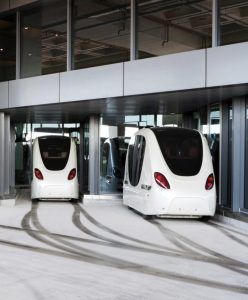Caroline Lester in The New Yorker:
 Today, cars with semi-autonomous features are already on the road. Automatic parallel parking has been commercially available since 2003. Cadillac allows drivers to go hands-free on pre-approved routes. Some B.M.W. S.U.V.s can be equipped with, for an additional seventeen-hundred dollars, a system that takes over during “monotonous traffic situations”—more colloquially known as traffic jams. But a mass-produced driverless car remains elusive. In 2013, the U.S. Department of Transportation’s National Highway Traffic Safety Administration published a sliding scale that ranked cars on their level of autonomy. The vast majority of vehicles are still at level zero. A car at level four would be highly autonomous in basic situations, like highways, but would need a human operator. Cars at level five would drive as well as or better than humans, smoothly adapting to rapid changes in their environments, like swerving cars or stray pedestrians. This would require the vehicles to make value judgments, including in versions of a classic philosophy thought experiment called the trolley problem: if a car detects a sudden obstacle—say, a jackknifed truck—should it hit the truck and kill its own driver, or should it swerve onto a crowded sidewalk and kill pedestrians? A human driver might react randomly (if she has time to react at all), but the response of an autonomous vehicle would have to be programmed ahead of time. What should we tell the car to do?
Today, cars with semi-autonomous features are already on the road. Automatic parallel parking has been commercially available since 2003. Cadillac allows drivers to go hands-free on pre-approved routes. Some B.M.W. S.U.V.s can be equipped with, for an additional seventeen-hundred dollars, a system that takes over during “monotonous traffic situations”—more colloquially known as traffic jams. But a mass-produced driverless car remains elusive. In 2013, the U.S. Department of Transportation’s National Highway Traffic Safety Administration published a sliding scale that ranked cars on their level of autonomy. The vast majority of vehicles are still at level zero. A car at level four would be highly autonomous in basic situations, like highways, but would need a human operator. Cars at level five would drive as well as or better than humans, smoothly adapting to rapid changes in their environments, like swerving cars or stray pedestrians. This would require the vehicles to make value judgments, including in versions of a classic philosophy thought experiment called the trolley problem: if a car detects a sudden obstacle—say, a jackknifed truck—should it hit the truck and kill its own driver, or should it swerve onto a crowded sidewalk and kill pedestrians? A human driver might react randomly (if she has time to react at all), but the response of an autonomous vehicle would have to be programmed ahead of time. What should we tell the car to do?
More here.
